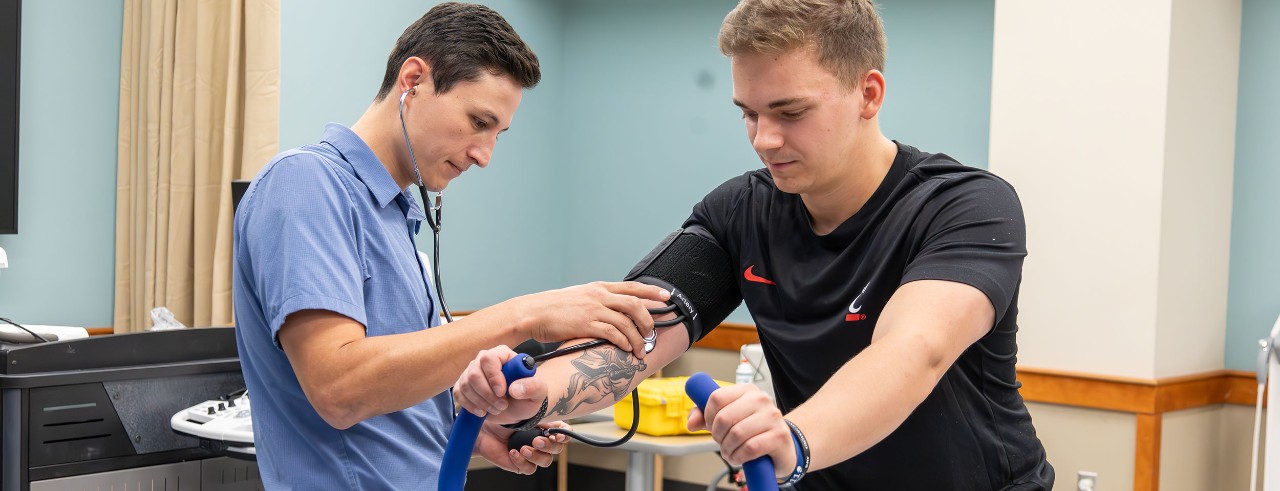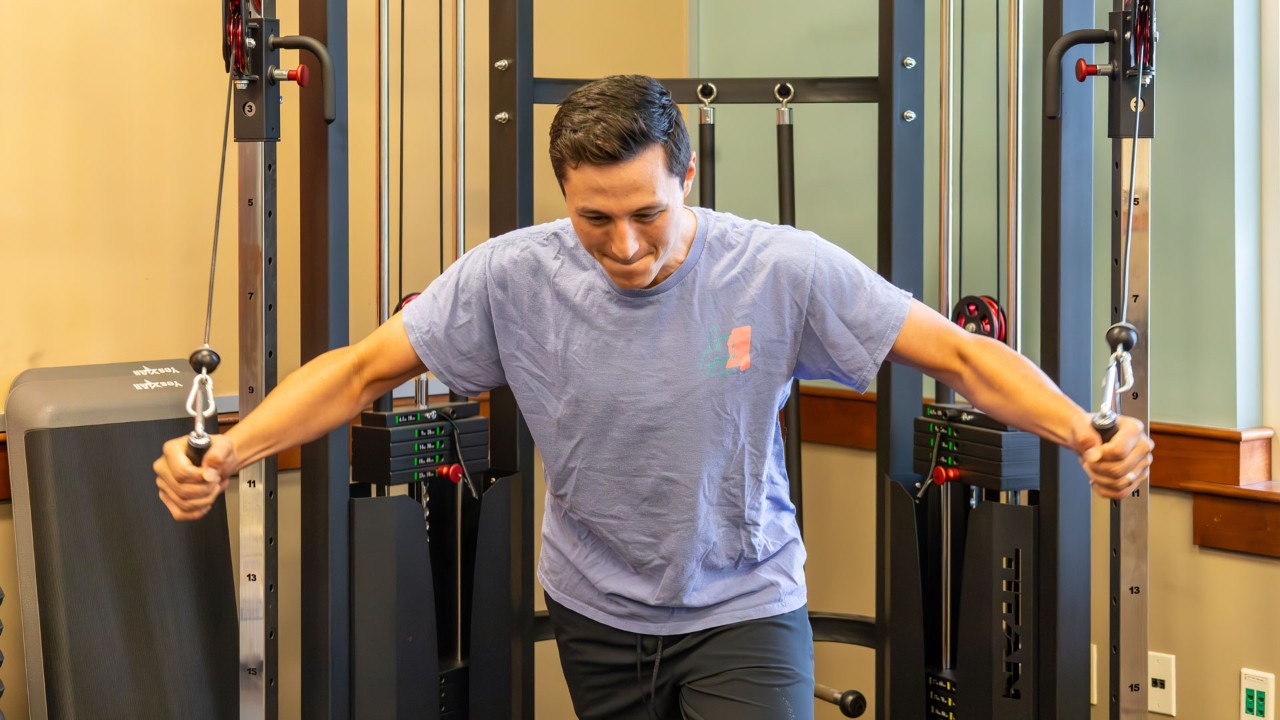
Bearcat Performance Lab expands exercise science research, engages the community
Lab is available to community members for fitness assessments
In the fall semester of 2024, the School of Human Services at the University of Cincinnati celebrated the grand opening of the brand-new Bearcat Performance Lab (BPL), which is … what, exactly?
It’s true that “performance” can be something of a nebulous term, with applications ranging from on-stage entertainment to how a professional goes about the duties of their job. But in the case of the UC’s new exercise testing and performance lab, “human performance” is the subject under scrutiny. And human performance is itself a very specific term, closely related to kinesiology, that addresses how the human body moves and responds, especially in relation to exercise.
As a tool of the Exercise Science program offered by the College of Education, Criminal Justice, Human Services, and Information Technology (CECH), the lab provides a dedicated space fully stocked with equipment to research and investigate physiological and cardiovascular responses to exercise for individuals and athletes of all ages and populations.

A BPL worker monitors an individual wearing a facial apparatus. Photo/CECH Marketing
“We have a wide range of really nice equipment enabling us to take a lot of different physiological measures,” explains Matt Chatlaong, Ph.D., an assistant professor with CECH’s Exercise Science program and director of the BPL. With research interests in cardiovascular and metabolic function, strength and conditioning performance, blood flow restriction modalities, cycling and non-invasive physiological measures, Chatlaong sees the BPL as an important resource for college researchers seeking insight into the science of human movement and exercise.
The lab is also an exciting advancement for both undergraduate and graduate students in the Exercise Science program, who can take advantage of the space to work alongside faculty members engaged in active research. In addition to enabling learners to gain hands-on experience with professional-grade equipment commonly used in the field, the BPL allows students to take part in athlete monitoring research, professional development, and presentation and publication opportunities.
Investigating mechanisms of fitness
In its initial year of operation, the lab will be tasked with research across a handful of main areas, including cardiovascular function and metabolic assessments in health, athletic and disease populations. The lab team is also interested in effects of hormone optimization and weight loss medication on arterial function, body composition, and daily activity and fatigue.
“We have the opportunity to take different non-invasive cardiovascular and metabolic measures as well as strength and power measurements that are commonly used in athletics and strength and conditioning settings,” explains Chatlaong. “We’re able to investigate mechanisms of fitness—what aspects of a person’s cardiovascular system are improving, what aspects of their metabolic systems are improving. That sort of thing.
“We have the ability to start answering, non-invasively and in applied ways, questions of how we can increase fitness.”
Matt Chatlaong, Ph.D. Bearcat Performance Lab
The performance lab space has been in the works for some time according to Gabe Sanders, Ph.D., who was tasked with making the idea a reality by program coordinator Julia Buchanan, Ph.D. “The goal was always to create a lab for research,” says Sanders. “When I was hired, it was encouraged for me to start a community testing component of the lab, as I had started human performance testing at my previous university.”
Enhancing community health
This community testing program is a notable feature, as the lab was designed to also serve the public by providing fee-based comprehensive fitness assessments of a variety of fitness factors.

Assistant professor Matt Chatlaong demonstrates use of one of the BPL's weightlifting machines. Photo/CECH Marketing
“Essentially we’re trying to use our expertise combined with the equipment in a way that people can use outside of being a part of the Exercise Science program or being a part of a research study or anything like that,” says Chatlaong. He notes there’s a signup form available on the BPL website that people can use to get in touch. “What we’ll do is go through what the comprehensive fitness assessment will include and different results we’ll get. And then if folks are interested in proceeding, we’ll discuss what protocols will work best for them and find a time to have them come into the lab.
“And the important application of this sort of testing is to be able to track progress, so the goal would be to have it not just be a one-time thing,” adds Chatlaong. “We would encourage folks to do the testing, do training outside of the lab, then come back to see what kind of progress that is having on their body. We can go through some of the results with them each time.”
BPL assessments offer obvious benefits to athletes seeking to optimize physical performance. But Chatalong notes that the lab’s services can provide insights for a range of individuals, including those new to exercise, fitness club members, runners and cyclists, and even civil servants such as firefighters and police officers for whom physical ability can be essential.
“We want to help those in the community access to state-of-the-art equipment that can measure health parameters,” says Sanders. “Then we can make objective recommendations about their test results to help them improve health and performance.”
The cutting-edge equipment in the lab is a mixture of new pieces and machines lightly used for research and classroom purposes in the Exercise Science program. Chatlaong is especially excited about a machine known as the InBody 770 Body Composition and Body Water Analyzer. “That’s a really state-of-the-art, noninvasive, super-fast way to assess things like body fat percentage, muscle mass, lean mass—that sort of thing,” he says. “A person will stand on two electrodes and then grab two electrodes. It’s sort of like a really, really hi-tech scale in a way.”
You can learn more about the Bearcat Performance Lab at its website, as well as check out the full list of equipment currently in the lab. Interested in getting information about fitness assessments offered by the BPL? Read more and fill out the signup sheet here.
Featured image at top: Assistant professor Matt Chatlaong monitors the pulse of a lab participant performing exercise. Photo/CECH Marketing
Next Lives Here
The School of Human Services, located in the College of Education, Criminal Justice, Human Services, and Information Technology, is a dynamic and innovative program committed to excellence in raising the next generation of industry professionals. The School of Human Services offers a range of certificates, undergraduate, masters and doctoral programs to prepare students for their futures in the field of health and wellness.
Related Stories
UC study: Secondhand smoke sends more kids to the hospital
September 8, 2020
Children who are exposed to tobacco have higher rates of hospital admissions after visiting emergency departments or urgent care facilities, according to a new study by University of Cincinnati researchers.
UC student finds passion in community building
June 25, 2020
DaManuel Montgomery wants to leave a mark on the world. He found a way to do that in UC’s School of Human Services
